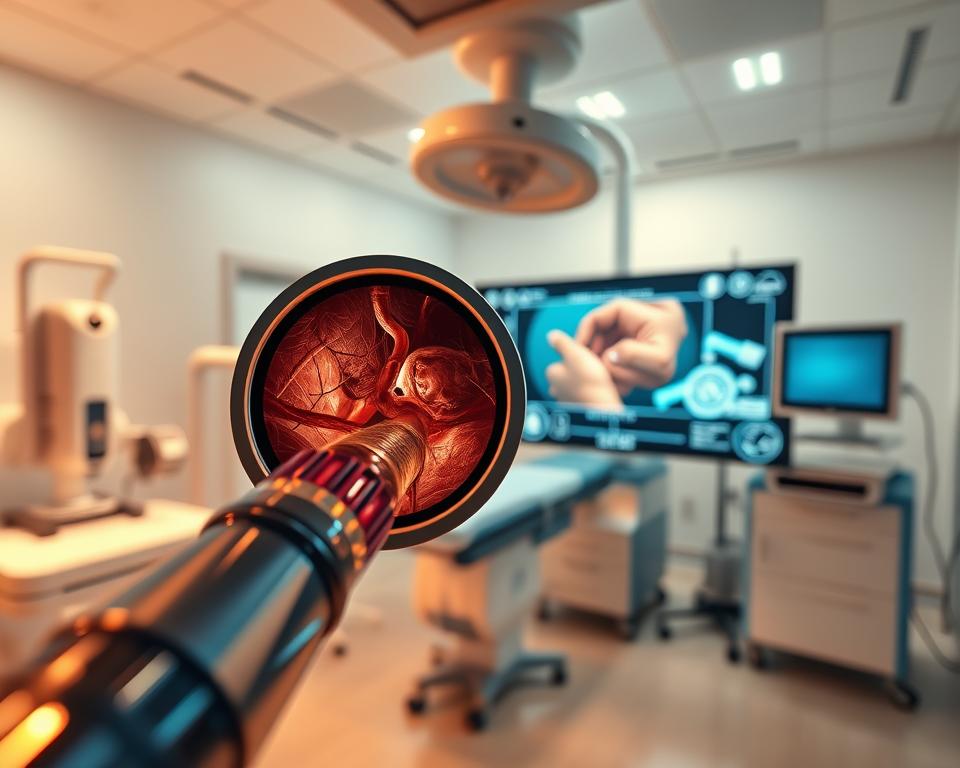AMT’s Endoscopy Services in Singapore Explained.
“Never stop questioning.” — Albert Einstein.
AMT’s endoscopy combines precise manufacturing with clinical services. In this overview, we explore how AMT links device manufacturing to supporting gastrointestinal procedures in Singapore.
Accuron Technologies recently made a big move with https://amt-mat.com/business/mim/. It placed Aurum Healthcare under Advanced Materials Technologies. It also added sterilization and cleanroom capabilities in Johor Bahru, reinforcing AMT’s presence in Tuas and Dongguan. Thanks to this, AMT can now handle a full chain from components to cleanroom assembly.
You’ll learn why AMT’s endoscopy services are essential for healthcare providers, device manufacturers, and patients. Topics cover manufacturing technologies and cleanroom services. We’ll talk about partnerships, clinical use cases, safety rules, the costs, training for the workforce, and new trends like AI, robotics, and miniaturization.
Singapore enables medical tourism in the region, which makes AMT’s endoscopy services important for Southeast Asia. Below we examine the technologies and clinical uses that keep modern medical endoscopy both effective and scalable.
AMT’s Role in Singapore’s Endoscopy & Medtech Manufacturing
Advanced Materials Technologies (AMT) is a key player in Singapore for making high-precision metal parts. Core strengths include metal injection moulding and metal additive manufacturing. AMT focuses on urology, endoscopic devices, and surgical robotics and supports the needs of international OEMs seeking top-notch components.
Company background and strategy
Accuron Medtech accelerates growth in the Asia-Pacific medtech scene, focusing AMT on medical devices. Its teams specialize in design-for-manufacturing across additive and MIM processes needed for top-tier endoscopy products.
Integrated Growth via Acquisitions
Acquiring Aurum expanded AMT with sterile cleaning and assembly. Aurum Healthcare’s Johor Bahru facility grew AMT’s capacity and scope, allowing coverage from metal parts to sterilization and plastic assembly.

Partnering with OEMs and Robotics
AMT helps endoscopy device makers with precise parts and cleanroom assembly. They manage everything from DFM to validating sterility, speeding up launches while strengthening quality and cost control.
By linking component production with sterilization and assembly, AMT becomes a strong partner for endoscopic and surgical robotics OEMs, simplifying programs, speeding validation, and preparing advanced tools for surgery.
Scope & Significance of AMT’s Endoscopy
Below we explain AMT’s role in healthcare and device making. “AMT’s endoscopy” means the parts and services AMT provides for endoscopic procedures—from high-precision metal components to cleanroom-assembled and sterilized tools used in clinical settings.
What It Means: Production vs Clinical
AMT produces precise metal parts via MIM and 3D printing, and handles cleanroom assembly, sterilization, and traceability for clinical use. These sterile, verified parts are essential for safe endoscopy.
Manufacturing versus clinical endoscopy services
AMT owns engineering, quality control, regulation, and production—not clinical care. Hospitals and clinics perform procedures using AMT’s parts, preserving a clear division of responsibilities.
Why Singapore’s cluster matters for regional healthcare and medical tourism
Singapore combines advanced manufacturing, strict regulation, and leading clinical centers, helping OEMs rapidly move designs to market. Local supply and services make Singapore a key location for medical endoscopy and attract regional patients.
- Quicker prototyping and supply for hospitals and center networks
- Quality systems aligned to export and domestic standards
- Tighter OEM-clinician feedback loops to refine devices
Understanding the line between AMT’s manufacturing and hospital services shows how the ecosystem drives better care, aiding doctors and enabling device companies to expand innovation.
AMT’s Technology Stack for Endoscopy
AMT produces key components for advanced endoscopy used in Singapore and by regional OEMs, combining conventional metal forming with modern processes to meet high standards.
MIM & Metal Additive
AMT specializes in small, strong parts—joints, tips, housings—via MIM, and uses 3D printing for complex shapes unsuitable for subtractive methods, improving assembly and delivering reliability.
Sterilisation, cleanroom assembly and quality systems
AMT offers validated sterilisation and clean assembly with ISO-aligned systems, including trackability for consumables and plastics, supplying catheter and disposable needs while staying compliant.
Miniaturization & Imaging
As parts shrink, e.g., camera housings, AMT meets precision demands where imaging and therapy converge—delivering tiny, durable components suited to modern scopes.
Benefits include fewer parts, consistent performance, and easier sterilisation checks—speeding development and enabling improved diagnosis and therapy.
GI Endoscopy Types Supported by AMT
GI endoscopy spans diagnostic checks to complex interventions. Device makers need tough, exact metal components and re-sterilizable tools—AMT supplies both manufacturing and sterile assembly for Singapore hospitals.
Diagnostics and Video Endoscopy
Diagnostic scopes employ imaging and biopsy features; video endoscopy needs rigid, stable housings. AMT provides tip components and biopsy forceps parts, maintaining image stability and device reliability.
Biopsy tools are sterilized and tracked; reliable components reduce downtime and enable AI-assisted workflows.
Therapy-Focused Procedures
Therapeutic tools—snares, cutters—need heat- and stress-resistant precision. AMT’s fabrication yields precise snare wires and cutters, with sterile lines making them OR-ready.
Interventional and hybrid procedures enabled by advanced components
Hybrid approaches mix endoscopy with other techniques, demanding specialized components. AMT enables navigation and robotic integrations via dependable designs and strict sterile processes.
- Tip assemblies for video and gastro scopes
- Precision snares and cutters for therapy
- Articulated linkages and connectors for interventional surgery
Clinical Benefits of Minimally Invasive Endoscopy
Minimally invasive endoscopy improves patient care in Singapore—quicker recovery and lower risks. With tiny tools and advanced optics, doctors work through small access points, cutting hospital time.
AMT provides precise parts and sterile items clinicians rely on for everyday care.
Less Sedation, Faster Recovery, More Comfort
Lower sedation is safer for the elderly and comorbid patients, enabling quicker discharge. Ergonomic devices and miniaturized parts keep procedures gentler, boosting acceptance.
Combined diagnostic and therapeutic capability in one session
Modern scopes enable diagnosis and therapy in a single visit, reducing risk and cost while enhancing convenience.
Improved diagnostic accuracy via HD imaging and AI
High-definition imaging reveals finer details; AI adds real-time analysis. Stable optics and mechanics support early detection and better planning.
- Stable, sharp imaging supports AI detection
- Precision builds maintain alignment and protection
- Validated sterile workflows lower infection risk
Endoscopy specialist workforce and training in Singapore’s AMT ecosystem
Singapore’s endoscopy teams blend clinical expertise and technical skill, supported by hospitals, national programs, and industry partners to sustain high quality.
Specialist skills for advanced procedures
Advanced techniques require precision and device fluency—mucosal resection, polypectomy, hemostasis—plus multi-disciplinary learning with robotics and AI. Simulators and structured assessments transfer knowledge safely; device literacy reduces risk.
Role of hospitals, training programs and manufacturers
Major hospitals run specialized training and ongoing education. Manufacturers provide device use, care, and maintenance training for practical understanding.
Blending courses with SG’s initiatives and OEM input builds a well-rounded learning path.
Concentration of expertise and access
Expertise concentrates in large centers, improving complex case outcomes and training, but challenging smaller sites. Regional patients visit Singapore for specialized care, highlighting its hub role.
Outreach, tele-mentoring, and broadened training help distribute excellence and reduce gaps.
Endoscopy Center Workflow & Patient Pathway
At Singapore endoscopy centers, the journey goes from referral to recovery with defined steps, including minimal-sedation or awake options.
Patient Expectations: Referral, Pre-Op, Consent
Pre-procedure checks review history, medications, bleeding risks, and fasting. Teams walk through benefits and risks with plain consent forms; many sites provide same-day pathways to reduce waiting.
Theatre standards, sterilisation workflows and cleanroom impacts
Clean theatres and validated instrument flows are critical. Unified sterilization, assembly, and device supply strengthen safety and simplify tracking of single-use items.
Documented workflows reduce infection risk and help ensure standards are met; working with one provider can speed supply and simplify chains.
Post-Procedure to Follow-Up
Post-procedure care centers on recovery, complication watch, and results communication. Linking with national records enables follow-ups and device traceability from manufacturer to patient.
Governance for Endoscopy Devices
In Singapore, endoscopy devices must meet rigorous standards. The Health Sciences Authority checks registration, documentation, and ongoing safety before clinic use.
Singapore’s Medtech Regulatory Landscape
Hospitals and suppliers show HSA compliance via risk management, clinical evidence, and quality checks. Global standards help streamline approvals for proven devices.
ISO, Sterility Validation & Traceability
Quality systems follow ISO frameworks. Sterilisation uses appropriate methods to assure sterility. AMT’s traceability tracks each device from build to use for rapid responses if needed.
Governance & Surveillance
Hospitals track performance and escalate issues via registries. AMT’s documentation supports clinicians and OEMs in addressing problems; oversight expands with smarter devices to cover data and responsibilities.
Costs, economics and access to advanced endoscopy in Singapore
Advanced endoscopy is not cheap for providers and patients—high-end scopes and robotics carry large capital costs plus maintenance contracts.
Costs increase with complex imaging and AI requirements. When OEMs handle sterilization and parts, costs can drop via integrated supply.
Training and dedicated spaces remain costly, affecting affordability. Large centers absorb costs better than smaller sites, impacting access.
Medical tourism adds revenue yet may tilt focus toward higher-end services, raising equity questions.
Leaders pursue group purchasing and partnerships to balance fairness with innovation.
What’s Next in Endoscopy
Rapid advances transform clinician-manufacturer collaboration in Singapore and the region. AMT’s supply chain connects precision manufacturing with clinical needs for performance and safety.
AI-Driven Detection helps spot subtle lesions, relying on stable feeds and consistent equipment so algorithms flag issues in real time.
Regulatory and ethical issues accompany AI adoption—validation for fairness, data handling, accountability, and consent must be addressed across makers and providers.
Navigation & Integration advance surgical precision via overlays, articulation, and robotics, where OEM-manufacturer coordination meets strict thresholds.
- Robots enhance reach and steadiness
- Navigation pinpoints tricky targets
- Hybrid approaches cut repeat procedures
Miniaturization trends lead to tiny cameras and instruments that require advanced metalwork and careful assembly able to withstand reprocessing while keeping clear views for AI.
Data-Intensive Workflows improve records and analytics but raise questions on ownership, use, and privacy—calling for solid rules for storage, sharing, and study.
Together, these trends help surgery more accurate and data-guided, needing strong ties among design, manufacturing, trials, and regulation to keep care safe, compliant, and effective.
Impact of AMT’s capabilities on regional healthcare and strategy
AMT’s mix of metals, sterile plastics, and assembled devices—augmented with Aurum—lets Southeast Asian hospitals procure advanced tools quickly, reducing wait times for endoscopy by amt procedures.
AMT strengthens Singapore’s medtech hub status, drawing APAC firms, speeding development, and spurring investment. With Accuron and AMT growing, Singapore’s global health role expands, supporting medical tourism and regional ties.
Challenges remain: high costs and specialized skills can limit access. AMT mitigates supply bottlenecks, but equitable policies remain crucial so benefits reach all.
By integrating MIM, 3D printing, and sterilisation, AMT gives Singapore an edge, attracting outsourcing and helping broader access to tools like AMT-supported endoscopy, benefiting both economy and public health.
Frequently Asked Questions
What Is “AMT’s Endoscopy Services in Singapore”?
It covers AMT’s manufacture and supply of endoscopy tools: metal parts via printing and molding, plastics, cleanroom assembly, sterilization, and tracking—making sure devices are hospital-ready.
About AMT and Its Capabilities
AMT is a Singapore manufacturer of precise medical parts using MIM and metal printing for areas like endoscopy; with Accuron’s medtech focus, AMT supports DFM and component supply across APAC.
How did AMT expand into sterilisation and cleanroom assembly?
Through Aurum Healthcare—placed within AMT via Accuron—adding Johor Bahru capabilities and China support to complement Singapore, enabling end-to-end manufacturing to sterile prep.
How Does AMT+Aurum Help OEMs & Robotics?
One-stop path to precision metals and plastics, cleanroom assembly, and sterilisation speeds launches, improves traceability, reduces quality risk, and manages costs under unified QA.
Clinical Service Scope
No. AMT supplies parts and assemblies; hospitals and specialists perform patient care. AMT focuses on devices.
Endoscopic Components from AMT
Tiny housings, tip components, forceps elements, snares, cutters, and linkages via MIM and metal printing for reliable procedures.
Why Additive & MIM Matter
They enable intricate, miniaturized parts, ease assembly, ensure quality, and serve higher imaging and precision needs.
What sterilisation and QA controls does AMT offer?
Validated sterilisation, cleanroom assembly, tracking, and ISO-aligned QA with records to satisfy safety and regulatory needs.
Procedures Using AMT Components
Diagnostics like gastroscopy, colonoscopy, video endoscopy; therapies like polypectomy and hemostasis—which require precise and sterile tools.
Advanced Procedure Support
Yes—custom metal parts and cleanroom workflows for complex procedures with dependable designs and strict sterility.
How do AMT’s products improve patient experience and workflow?
Smaller, ergonomic tools reduce discomfort and hasten recovery; reliable devices enable comprehensive single-session care and reduce risk.
Upskilling for Advanced Devices
More advanced tools demand robust training across hospitals, programs, and OEMs using simulators and device guidance for safe adoption.
Patient Journey Overview
Referral, assessment, consent, often outpatient flow; suppliers like AMT help ensure tools are sterile, reliable, and available throughout care.
Regulation & AMT’s Services
Compliance with HSA and international standards—sterility, QA, and tracking—helps keep devices safe and aligned with monitoring rules.
Risk Reduction via Tracking
End-to-end tracking and validated sterilisation allow fast issue response and reduce infection risk, supportive of hospital safety.
What drives the cost of advanced endoscopy?
Premium scopes, robotics, imaging, and AI contribute to capital and upkeep; integrated providers like AMT can help reduce waste and streamline supply.
Pricing & Access Effects
One-stop models may lower total cost for hospitals, but skills, space, and capital needs still limit access, favoring major centers.
What role does Singapore’s cluster play regionally?
Quality manufacturing, regulation, and clinics attract patients and investment; AMT expands regional tool access while equity stays a focus.
How does AMT support AI-enabled imaging stability?
Precision builds and clean assembly keep optical stability so AI can analyze frames consistently.
How do navigation, robotics and next-gen modalities interact with AMT?
Supplying complex, precise parts to endoscopy and surgical OEMs supports integrated, regulated, and sterile next-gen procedures.
What’s Next for AMT
Miniaturization, AI-rich imaging, and more robotics grow demand for precise parts and sterile consumables; AMT’s breadth supports faster client development.
AMT & Post-Market Surveillance
Records, traceability, and QA data enable incident reporting, corrective actions, and long-term compliance across hospitals and OEMs.
Regional Access & Policy
While AMT streamlines supply, training and cost gaps remain; regional policies should promote affordability and access as technology advances.

